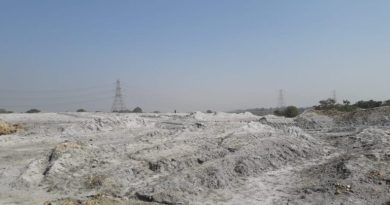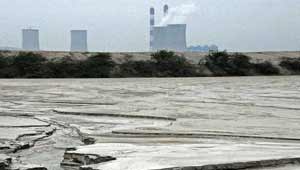Fly ash turning lives to ashes
Raipur | Correspondent: Residents of Korba, Chhattisgarh, are grappling with severe damage caused by fly ash from local thermal power plants.
Recently while Housing and Environment Minister OP Choudhary was discussing fly ash management, farmers in Korba were dealing with the fallout from a recent fly ash disaster.
Heavy rains on Thursday night caused a wall at the Kharmora power substation to collapse, leading to a thick layer of fly ash spreading across the substation, surrounding areas, and fields.
Farmers report that their crops have been destroyed, with fields now covered in ash.
The fly ash issue extends beyond the substation. It has also been dumped on the banks of the Hasdeo River, with recent rains causing it to flow into the river, threatening its ecosystem.
The fly ash problem is ongoing for Korba residents. Thermal power plants release hundreds of tons of fly ash daily, and storage ponds are overflowing.
Despite efforts to repurpose the ash for mine filling, road construction, and brick-making, these measures have not alleviated the problem.
In summer, fly ash clouds affect Korba and nearby villages, while in the rainy season, it contaminates fields and water sources.
Local residents are calling for urgent government action to address this persistent issue.
Consumption Deadline Keeps Getting Extended Yearly
The deadline for the complete use of fly ash from thermal power plants keeps being pushed further.
The Ministry of Environment and Forests set guidelines for 100% utilization of fly ash back in 1999, but many states still haven’t fully implemented this order.
In the first half of 2022-23, 142.0653 million tonnes of fly ash were produced by 175 thermal power stations with a total capacity of 205,623 MW across the country.
The central government reports that 111.0124 million tonnes of this ash have been utilized.
In Chhattisgarh, 20.6330 million tonnes of fly ash were generated from 23 thermal power plants producing 23,520 MW of electricity, but only 14.5693 million tonnes have been used.
Thousands of tonnes of fly ash dumped across the state
In the first half of 2022-23, the utilization of fly ash from several major thermal power plants in Chhattisgarh was notably low.
At NTPC’s 2,600 MW power plant in Korba, only 19.59% of the 2.5562 million tonnes of fly ash produced was used, amounting to 0.5008 million tonnes.
Similarly, from NTPC’s 2,980 MW power plant in Sipat, Bilaspur, only 36.19% (0.9338 million tonnes) of the 2.5801 million tonnes produced was utilized.
The 1,600 MW power plant in Lara, Raigarh, managed to use just 16% (0.3034 million tonnes) of the 1.8282 million tonnes of fly ash generated.
At the 500 MW Shyama Prasad Mukherjee power plant in Korba, 41.26% (0.2394 million tonnes) of the 0.5802 million tonnes produced was used.
Meanwhile, the 1,340 MW Hasdeo power plant in Korba utilized only 29.62% (0.4088 million tonnes) of the 1.3803 million tonnes of ash produced.
On a national level, during the same period, 175 thermal power stations with a total capacity of 205,623 MW produced 142.0653 million tonnes of fly ash.
Of this, 111.0124 million tonnes, or 78.14%, was utilized.
Ash dykes at full capacity
In Chhattisgarh, the accumulation of fly ash has reached alarming levels. As of March 2023, the ash dyke ‘Dhanras Rakhadbandh’ in Korba, which stores fly ash from NTPC, held 1,056 lakh metric tonnes of ash.
In addition, state government power plants in Korba have deposited 520.12 lakh metric tonnes of fly ash in the ‘Daganiakhar, Lotlota, and Jhabu Rakhadbandh,’ and 192.557 lakh metric tonnes in ‘Pandripani Rakhadbandh.’
According to the Housing and Environment Department, the total fly ash accumulated in Korba had reached 1,962.547 lakh metric tonnes by April 2023.
The situation is worsening daily, with large ash mounds forming in Korba and surrounding areas. During the rainy season, this ash dissolves and contaminates fields and water sources.
Illegal dumping of fly ash spreads across Chhattisgarh
In Chhattisgarh, districts such as Korba, Raigarh, Janjgir-Champa, and Bilaspur are facing a serious issue with the illegal dumping of fly ash.
Power generation companies are disposing of fly ash on public lands, farms, forests, drains, ponds, roads, crematoriums, school grounds, and even within city limits.
This practice, which is supposed to be managed by dumping ash in low-lying areas, is severely impacting public life and causing widespread environmental damage.
Despite several directives from the National Green Tribunal (NGT) over the years aimed at controlling the damage caused by fly ash, illegal dumping persists.
The Chhattisgarh High Court has taken action by appointing three advocates as amicus curiae to investigate the matter, following petitions about the detrimental effects of ash dumping.
Numerous petitions have also been filed in the High Court and Supreme Court addressing pollution issues related to fly ash in Korba.
The government had previously mandated that fly ash be used to fill land vacated by coal mining.
However, this directive has not been effectively implemented, and there appears to be a lack of interest in enforcing these regulations.
Fly ash contamination causing severe health issues
Fly ash from thermal power plants is severely affecting both public health and land fertility in Chhattisgarh.
According to the State Health Resource Center, a survey conducted four years ago revealed that irrigation water is contaminated with fly ash, harming paddy fields.
Many farmers have abandoned their lands due to decreased crop productivity.
A separate survey conducted two years ago reported that air pollution levels in Korba are 28 times higher than national standards.
According to the Air Quality Report-2021 by the State Health Resource Center, the standard level of particulate matter 2.5 (PM 2.5) is 60 µg/m³ in India and 10 µg/m³ globally.
However, in Korba, the report found PM 2.5 levels at dangerously high levels in 14 surveyed areas.
For instance, PM 2.5 levels in the Imli Chhapar area were measured at 1,613.3 µg/m³, and in Gandhi Nagar Sirki at 1,699.2 µg/m³.
The PM 2.5 level at Balco checkpost, though lower, was still 150.3 µg/m³, significantly above the standard.
The report also found elevated levels of harmful substances in the air: silica at 89.9 µg/m³ (standard is 3 µg/m³), nickel at 0.050 µg/m³ (standard is 0.0025 µg/m³), lead at 0.117 µg/m³ (standard is 0.15 µg/m³), and manganese at 0.994 µg/m³ (standard is 0.15 µg/m³).
These conditions have had a direct adverse effect on residents, impacting their nervous systems, lungs, respiratory systems, hearts, kidneys, skin, blood, and eyes.
GPS tracking mandated for fly ash disposal
On Friday, State Housing and Environment Minister OP Choudhary convened a review meeting with all regional officers at the Chhattisgarh Environment Protection Board office in Nava Raipur.
During the meeting, Choudhary directed industries to strictly adhere to regulations for the transportation and disposal of fly ash.
He also mandated the use of GPS systems and geo-tagging for vehicles involved in fly ash management to ensure proper disposal and prevent illegal dumping.
The effectiveness of these directives in addressing the fly ash issue will be observed over time.




